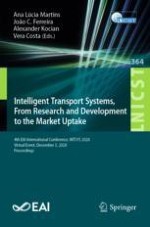2021 | Book
Intelligent Transport Systems, From Research and Development to the Market Uptake
4th EAI International Conference, INTSYS 2020, Virtual Event, December 3, 2020, Proceedings
Editors: Ana Lúcia Martins, João C. Ferreira, Alexander Kocian, Vera Costa
Publisher: Springer International Publishing
Book Series : Lecture Notes of the Institute for Computer Sciences, Social Informatics and Telecommunications Engineering
